 |

Basic Tying
Instructions
Anatomy of a
Fly
Salmon and
Steelhead Hooks
Fly Tying
Tools
Materials
Glossary

Fly Search
Match Flies to Species
Contributing Tyers
Show Your Flies Here

Steelhead Facts
Pacific Salmon
Facts
Tips and Techniques
Forum
Site Map

Flies
Issues
Photo Gallery
|
 |
|
By
Don Johnson
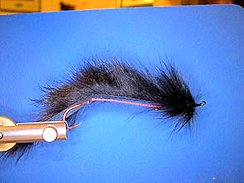 Tandem
flies fill a definite niche in the many disciplines of fly angling. The major
deterrent associated with tandems from a tying point of view stems mostly from
the fact that they can be laborious, time-consuming productions. In my search
for a satisfactory, fast method of manufacturing a tandem hook setup for
commercial application, I came across numerous techniques, none of which
resembles that which I will later describe. All of the techniques encountered
during my search were ones that I had tried, disliked and
wouldn't employ because I considered them too labor-intensive. In my
quest simplify the tandem-fly chassis in general and the stinger (rear hook)
connection in particular, I joined a stinger to a lead hook in a way that is
simple, versatile and adaptable. The beauty of this method is that the coupling of the stinger hook to the
connecting material requires no tools (usually), no knots, no thread and no
glue. All that is needed is a hook (either up-eye or down-eye) and about 12
inches of connection material, which will be examined later in greater detail. Tandem
flies fill a definite niche in the many disciplines of fly angling. The major
deterrent associated with tandems from a tying point of view stems mostly from
the fact that they can be laborious, time-consuming productions. In my search
for a satisfactory, fast method of manufacturing a tandem hook setup for
commercial application, I came across numerous techniques, none of which
resembles that which I will later describe. All of the techniques encountered
during my search were ones that I had tried, disliked and
wouldn't employ because I considered them too labor-intensive. In my
quest simplify the tandem-fly chassis in general and the stinger (rear hook)
connection in particular, I joined a stinger to a lead hook in a way that is
simple, versatile and adaptable. The beauty of this method is that the coupling of the stinger hook to the
connecting material requires no tools (usually), no knots, no thread and no
glue. All that is needed is a hook (either up-eye or down-eye) and about 12
inches of connection material, which will be examined later in greater detail.
Of course, as with everything else I have encountered in fly tying,
there is not much in the way of technique that is new or earth-shattering. I
rambled on, (re)inventing the wheel at my own pace completely oblivious as to
this technique's existence. As it turns out, this method had already been
developed, just not publicized in literature or known to me. A gentleman named
Don Ordes mentioned that he first used this technique about 15 years ago. He,
like myself, was not shown or introduced to the technique but just happened to
stumble upon it, refine it and adapt it as necessary to suit his angling needs.
His needs happen to be a lot more demanding than those of mine. Don's furled
tandems have held 150+ pound billfish. That should be clear evidence that the
connection is quite strong.
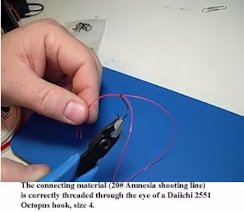 To
begin construction, take 12 inches of 30 pound-test backing material and a
Daiichi 2553 octopus hook and double the backing so it is shaped like a "U".
There should now be a loop at one end and the two tag ends should be of equal
length. If you are right-handed, hold the hook between your thumb and index
finger of your left hand as if it were mounted in your vise. Thread the loop-end
up through the hook-eye (or the tag ends down through the eye) so there is about
a one-inch loop dangling over the shank of the To
begin construction, take 12 inches of 30 pound-test backing material and a
Daiichi 2553 octopus hook and double the backing so it is shaped like a "U".
There should now be a loop at one end and the two tag ends should be of equal
length. If you are right-handed, hold the hook between your thumb and index
finger of your left hand as if it were mounted in your vise. Thread the loop-end
up through the hook-eye (or the tag ends down through the eye) so there is about
a one-inch loop dangling over the shank of the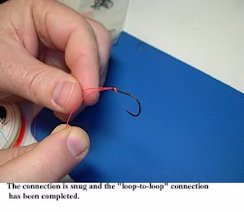 hook and the fingers of your left hand. Now, pinch the hook-eye between your
right thumb and index finger and pull the shank of the hook through the loop
with your left hand. Then, simultaneously pull both tag ends of the backing to
snug the loop up against the eye of the hook. Basically what has just occurred is that a loop to loop connection has been made with the hook-eye and the loop
in the backing.
hook and the fingers of your left hand. Now, pinch the hook-eye between your
right thumb and index finger and pull the shank of the hook through the loop
with your left hand. Then, simultaneously pull both tag ends of the backing to
snug the loop up against the eye of the hook. Basically what has just occurred is that a loop to loop connection has been made with the hook-eye and the loop
in the backing.
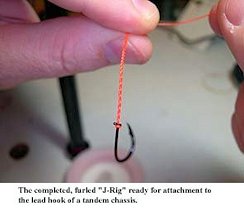 If
the process ended at that point
the stinger would "float" on the loop, which, in my
opinion, would be unacceptable. To "lock" the stinger in place, take the tag
ends, one each pinched between your thumb and index finger of each hand, and
pull them directly apart from one another. There should now be a straight line
between your hands with the hook approximately in the middle. Now, twist each
tag end in opposite directions while keeping the backing material If
the process ended at that point
the stinger would "float" on the loop, which, in my
opinion, would be unacceptable. To "lock" the stinger in place, take the tag
ends, one each pinched between your thumb and index finger of each hand, and
pull them directly apart from one another. There should now be a straight line
between your hands with the hook approximately in the middle. Now, twist each
tag end in opposite directions while keeping the backing material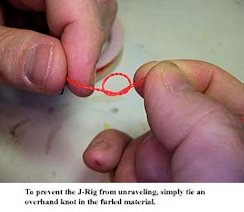 taut. When the backing material has become
sufficiently twisted, which will vary with the type
of material being used, the act of bringing your hands together will cause a
furling of the material. This furling will lock the stinger hook in place on the
loop. This is what I have come to
refer to as a 'J-Rig'
(because it resembles the letter).
At this point, the completed J-Rig (stinger and
taut. When the backing material has become
sufficiently twisted, which will vary with the type
of material being used, the act of bringing your hands together will cause a
furling of the material. This furling will lock the stinger hook in place on the
loop. This is what I have come to
refer to as a 'J-Rig'
(because it resembles the letter).
At this point, the completed J-Rig (stinger and 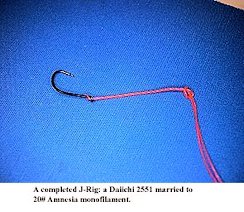 furled
connection) is ready to be tied onto the lead hook.
Unlike traditional
stinger assemblies, no tools, no glue, no knots and no thread were used to construct the J-Rig. When the furled connection material is lashed to the lead
shank with tying thread in such a manner that the J-Rig extends off the back
(bend), a tandem chassis has been completed. If manufactured in advance, to
prevent the J-Rig from unraveling, simply tie a tight, overhand knot in the
furled connection material (both tag ends) a few inches
up from the stinger hook. The pre-manufacturing of numerous J-Rig setups speeds up the process of tying a complete tandem fly at a later time. furled
connection) is ready to be tied onto the lead hook.
Unlike traditional
stinger assemblies, no tools, no glue, no knots and no thread were used to construct the J-Rig. When the furled connection material is lashed to the lead
shank with tying thread in such a manner that the J-Rig extends off the back
(bend), a tandem chassis has been completed. If manufactured in advance, to
prevent the J-Rig from unraveling, simply tie a tight, overhand knot in the
furled connection material (both tag ends) a few inches
up from the stinger hook. The pre-manufacturing of numerous J-Rig setups speeds up the process of tying a complete tandem fly at a later time.
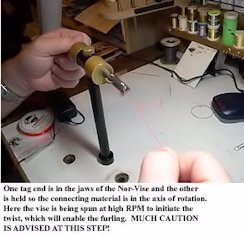 This
technique of furled connections has been successfully employed while using
Gudebrod braided Dacron backing material of differing pound-tests, monofilament
(Climax tippet and Amnesia shooting line, Gudebrod Lead-Free Trolling Line and
American Fishing Wire stainless steel leader material. For stiff materials such
as the trolling line and heavier stainless leader material, it is necessary to
enlist tools to facilitate sufficient twist in the material to initiate furling.
In these instances, one of the tag ends was tightened into the jaws of a This
technique of furled connections has been successfully employed while using
Gudebrod braided Dacron backing material of differing pound-tests, monofilament
(Climax tippet and Amnesia shooting line, Gudebrod Lead-Free Trolling Line and
American Fishing Wire stainless steel leader material. For stiff materials such
as the trolling line and heavier stainless leader material, it is necessary to
enlist tools to facilitate sufficient twist in the material to initiate furling.
In these instances, one of the tag ends was tightened into the jaws of a Nor-Vise and the other was held stationary in the axis of rotation while the material was twisted. The act of twisting the material with the Nor-Vise
can be done at a very high rate of revolution and much care must be taken as
this causes the hook to rotate at a high rate of speed as well. So as
to not impale one's self with a hook it is best to proceed with this part of
the process after constructing a "sheath" for the hook
and with slow, controlled revolutions.
Nor-Vise and the other was held stationary in the axis of rotation while the material was twisted. The act of twisting the material with the Nor-Vise
can be done at a very high rate of revolution and much care must be taken as
this causes the hook to rotate at a high rate of speed as well. So as
to not impale one's self with a hook it is best to proceed with this part of
the process after constructing a "sheath" for the hook
and with slow, controlled revolutions.
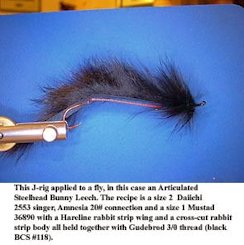 The
merits of this technique are many and it must be noted that experience has shown
this furling technique to be best applied using either up or down-eye hooks if
it is desired that both hooks be aligned with one another. When using a
straight-eyed hook, the shank of the stinger will not be in the same axis as
that of the lead hook. The
merits of this technique are many and it must be noted that experience has shown
this furling technique to be best applied using either up or down-eye hooks if
it is desired that both hooks be aligned with one another. When using a
straight-eyed hook, the shank of the stinger will not be in the same axis as
that of the lead hook.
Although the exact origin of this time-saving technique is dubious, the
furled-stinger method greatly reduces the time investment previously requisite
of tandem-tied flies. Many thanks to Bill Chase of Angler Sport Group/Daiichi,
Norm Norlander of The Norlander Company (Nor-Vise), Paul Black of Gudebrod, Don Ordes of Fantasy Fly Company, Ron McKusick of Featherside Flies, Christopher
Armour, Dean Endress and Lou Hurlbut for their input and assistance during the
development, or redevelopment as it is, of this technique.
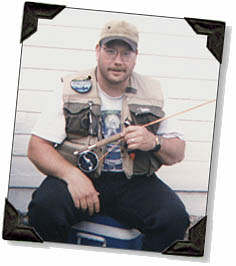
Don Johnson is an environmental chemist by profession who is also contract fly tier
for Pacific Fly Group and enjoys appointments to the following manufacturer's
pro-staffs: The Norlander Company (Nor-Vise), Daiichi/Angler Sport Group,
Gudebrod Inc., Ross Reels and St. Croix Rod Company.
Copyright 2003
Don Johnson
Photos by Lou Hurlbut
|
 |